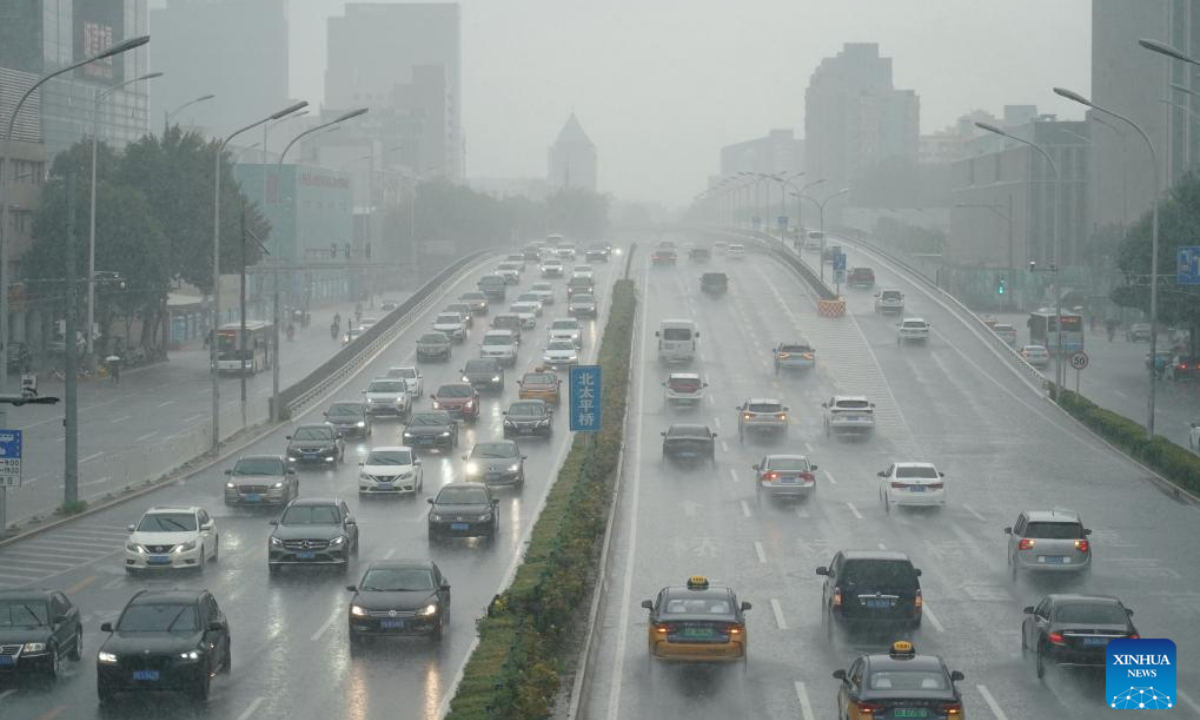
Vehicles move in the rain on a road in Haidian District, Beijing, capital of China, on July 29, 2023. Impacted by Typhoon Doksuri, the fifth typhoon of this year, heavy rainfall has hit regions in northern China, including Beijing, Hebei and Shandong. Photo:Xinhua
Zhuozhou in North China's Hebei Province, with a permanent population of more than 600,000 has been severely affected by rain-triggered floods, with more than 133,000 residents being affected, covering an area of 225.38 square kilometers. Rescue forces from all over the country came one after another, bringing supplies and professional rescue equipment. Efforts are still in progress, according to the local authorities on Tuesday.
Zhuozhou needs a large number of boats to relocate residents, as water supply has been cut off while power has been lost in some parts of the city, although supplies remain sufficient, Zhuozhou public security authorities said via Weibo on Tuesday afternoon. Boats (preferably larger wooden or metal boats), kayaks, life jackets, and water are all needed, officials said.
According to help forms circulated online, many residents and villagers have lost their cell phone connection. Shao Jun, a member of the Blue Sky Rescue Team, a Chinese civil relief squad, in Zhuozhou told the Global Times on Tuesday afternoon that he had received more than 300 requests for help from
Zhuozhou.
A local resident living in Yixian county, about 70 kilometers away from Zhuozhou said that his cousin currently lives in Zhuozhou, but the water and electricity has been cut off due to impact of flooding.
More than 600 people were trapped in Zhuozhou after heavy rainfall caused a collapse in the basement of a residential community, the members from the Rescue Team of Ramunion, based in Hangzhou, East China's Zhejiang Province have participated in the rescue efforts, according to media reports.
The local Zhuozhou People's Hospital is facing limited access to electricity, and the rescue team helicopter will arrive on Monday night to participate in the rescue to transfer critical patients, said the media reports.
As of 10 am on Tuesday, more than 133,000 residents from 146 villages have been affected, covering an area of 225.38 square kilometers, while 9,726 mu (648.4 hectares) of agricultural land had been affected by 5 pm on Monday, said Zhuozhou authorities.
The flood situation in Zhuozhou of North China's Hebei Province aroused wide attention online. As of Tuesday night, the hashtag of "Zhuozhou heavy rainfall" had received more than 240 million views online, with many netizens express for support for people in the city.
Zhuozhou issued a Level-I emergency response for major meteorological disasters (heavy rain) on Saturday and all departments at all levels of the city were required to immediately launch emergency response measures for a rainstorm disasters, and do their best to prevent and respond to heavy rainfall according to the pre-arranged plans.
Zhuozhou has organized 28 emergency rescue teams encompassing a combined 8,755 members to cooperate with professional rescue teams, including the Blue Sky Rescue Team, a Chinese civil relief squad.
From 8 am on Saturday to 11 am on Tuesday, Zhuozhou was again hit by heavy rainfall, with the average precipitation reaching 355.1 millimeters, local officials announced.
Affected by the upstream flood transit, Zhuozhou river flood and urban waterlogging risk intensified, so that the flood control situation is very serious. In Xiaoqing River flood diversion area, more than 83,100 residents from seven towns, 67 villages have been relocated, while remaining residents were expected to be relocated as of 6 pm on Tuesday. In another flood diversion area, 42,000 residents have been transferred, according to Zhuozhou authorities.
Affected by Typhoon Doksuri, starting from Saturday, Beijing, Tianjin, Hebei and other places continued to suffer from heavy rainfall, with seven red alerts for heavy rain issued within three days, and the rainfall period lasted about 70 hours.
In many parts of Hebei, the disaster was extremely serious, among which the flow of many rivers in Zhuozhou increased significantly, with newly added flood waters covering an area of about 20 square kilometers.




